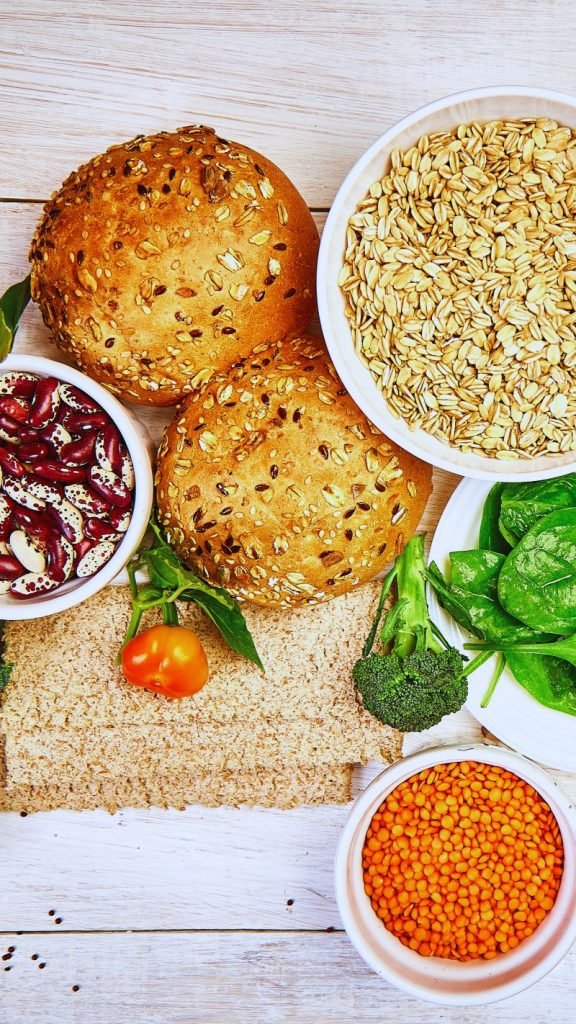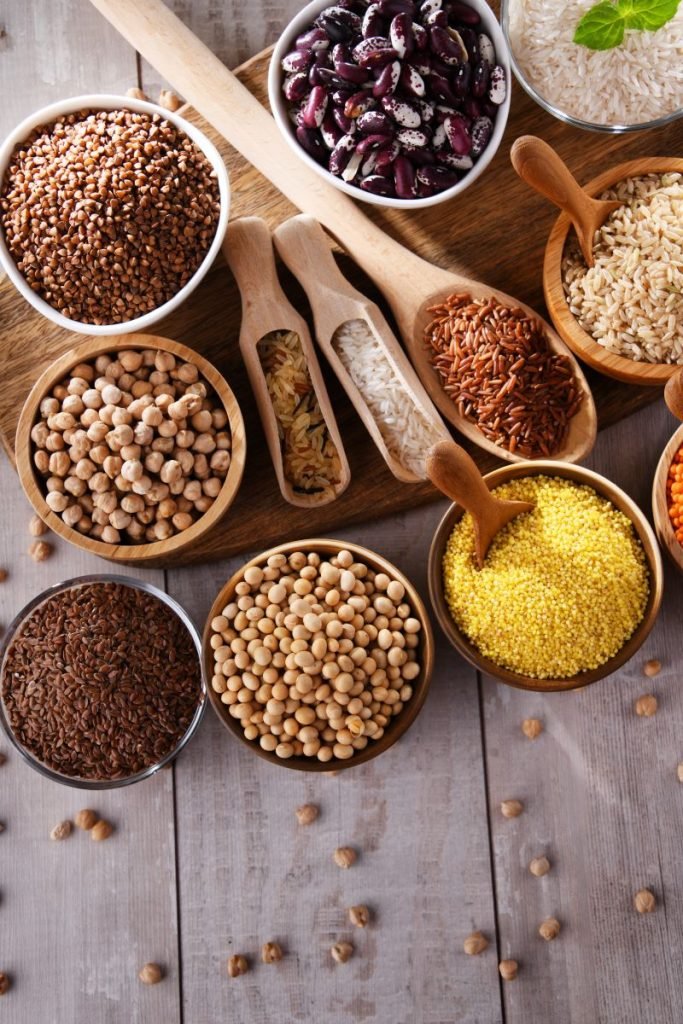The words dietary fiber might not be strange to you. In fact, the health benefits of dietary fiber are increasingly become popular nowadays. This is all thanks to an increase in both the knowledge and awareness of healthy eating. What then is dietary fiber and why must it feature in your diet every day?
What is Dietary Fiber?
Dietary fiber is a kind of carbohydrate that is not digested by the enzymes in the body. As a result, it is not absorbed into the blood stream either. Instead, dietary fiber arrives the the large intestines intact, where it serves as food for healthy bacteria that live there (1).
Types of Dietary Fiber
Dietary fiber can be broadly divided into two groups, soluble and insoluble fiber (1, 2).
Soluble fiber
This is fiber that dissolves in water when consumed. It forms a sticky gel which slows down the movement of food from the stomach to the small intestine.
Foods that are rich in soluble fiber are:
- beans
- barley
- chia seeds
- oats
- potatoes
- pears
- nuts
Insoluble fiber (roughage)
This is fiber that does not dissolve in water when consumed. It rather draws water from the intestine which increases the bulk of feces and makes it softer too.
Foods that are rich in insoluble fiber are:
- whole wheat grains (including whole wheat grain products)
- whole bran
- whole corn
- carrots
- fruits with edible peels (apples, pears, gauvas)
- legumes
- seeds
- leafy greens (collards, kale, spinach, turnip greens)

Health Benefits of Dietary Fiber
The health benefits of dietary fiber have been sufficiently demonstrated in several research studies in recent years. Below are five of the most researched and reported of these health benefits.
Prevention of constipation
Insoluble fiber draws water from the intestine which consequently increases the volume of stool. This makes stool softer and easier to pass out. Hence, insoluble fiber improves bowel movements and ultimately prevents constipation (1, 2).
A person is said to be constipated when they have difficulty emptying their bowels because of hard feces. Constipation can cause stomach bloating, abdominal pain, stomach cramps, and loss of appetite (3).
In severe causes, it could result in complications such as anal fissures (tear of the skin around the anus), piles (hemorrhoids), rectal bleeding and rectal tissue hanging out of the anus (3).
Helps with weight loss/management
Foods that are rich in fiber usually do not contain too many calories compared to other foods of the same volume. A 100g serving of cooked red kidney beans for example, contains only 127 calories (4).
Farther, soluble fiber slows down the exit of food from the stomach to the small intestine. This keeps one full for a longer period and helps curb down eating frequency. Less eating reduces calorie intake which can eventually lead to weight loss (5).
Lowers cholesterol level
Fiber regulates blood cholesterol levels by binding to cholesterol molecules and preventing their absorption into the blood stream.
Several research studies have reported that people who eat a fiber rich diet tend to have lower blood cholesterol levels than does that do not (6).
High blood cholesterol increases a person’s risk of developing chronic diseases like atherosclerosis, and heart disease (6).
Lowers blood sugar
Fiber slows down the digestion of digestible carbohydrates to glucose. This is because soluble fiber forms a thick gel when eaten that eventually slows down the exit of food from the stomach.
Consequently, glucose is absorbed at a much slower rate into the blood stream which is ideal for blood sugar control especially in diabetics (7).
Reduces the risk of colon cancer
Dietary fiber has cancer prevention activities in the colon. By drawing water from the intestine, insoluble fiber increases the volume of stool, which helps to dilute carcinogens (substances that cause cancer) in feces.
Also, dietary fiber reduces the time carcinogens spend in contact with the lining of the colon by increasing bowel movements.
Furthermore, healthy bacteria in the colon ferment fiber, releasing products like short chain fatty acids. These fermentation products also protect the colon from cancer (8).
How to increase your intake of dietary fiber
Interestingly, foods rich in dietary fiber are very affordable and vast. They are also readily available across seasons. Below are a few tips to adding dietary fiber to your everyday diet (2, 9).
- Eat a variety of fruits and vegetables daily.
- Eat the edible peels and seeds of fruits that have them like apples and pears.
- Eat more whole grains (brown rice, whole corn, whole wheat flour and other whole grains) than processed grains (white rice).
- Consume more whole fruits than processed fruit juices. This is because fiber is drastically removed during the processing of these fruit juices.
- Eat nuts like almonds and cashew nuts for snack instead of highly process snacks (crackers, potato chips).
- Manually add fiber to your food when cooking to enrich meals. Flaxseeds and chia seeds for example go well with soups and stir fries.
Recommendations
Dietary fiber is an essential nutrient in any healthy diet. The USDA (United States Department of Agriculture) recommends that adults consume about 50g of fiber a day. They recommend that women consume an average of 25g of fiber per day and men and average of 38g (9). Eating a variety of fiber rich foods daily is the best way to maximize all the amazing health benefits of dietary fiber.
References
- Fiber. (2012, September 18). Retrieved April 1, 2023, from The Nutrition Source website: https://www.hsph.harvard.edu/nutritionsource/carbohydrates/fiber/
- High Fiber Diet: Types of Food & Health Benefits. (n.d.). Cleveland Clinic. Retrieved April 1, 2023, from https://my.clevelandclinic.org/health/articles/14400-improving-your-health-with-fiber
- Constipation. (n.d.). Retrieved April 1, 2023, from Hopkinsmedicine.org website: https://www.hopkinsmedicine.org/health/conditions-and-diseases/constipation
- FoodData Central. (n.d.). Usda.Gov. Retrieved April 1, 2023, from https://fdc.nal.usda.gov/fdc-app.html#/food-details/175194/nutrients
- Salleh, S. N., Fairus, A. A. H., Zahary, M. N., Bhaskar Raj, N., & Mhd Jalil, A. M. (2019). Unravelling the effects of soluble dietary fibre supplementation on energy intake and perceived satiety in healthy adults: Evidence from systematic review and meta-analysis of randomised-Controlled Trials. Foods (Basel, Switzerland), 8(1), 15. doi:10.3390/foods8010015
- CDC. (2022, July 27). Fiber: The carb that helps you manage diabetes. Retrieved November 25, 2022, from Centers for Disease Control and Prevention website: https://www.cdc.gov/diabetes/library/features/role-of-fiber.html
- FoodData central. (n.d.-u). Retrieved November 25, 2022, from Usda.gov website: https://fdc.nal.usda.gov/fdc-app.html#/food-details/175200/nutrients
- Salleh, S. N., Fairus, A. A. H., Zahary, M. N., Bhaskar Raj, N., & Mhd Jalil, A. M. (2019). Unravelling the effects of soluble dietary fibre supplementation on energy intake and perceived satiety in healthy adults: Evidence from systematic review and meta-analysis of randomised-Controlled Trials. Foods (Basel, Switzerland), 8(1), 15. doi:10.3390/foods8010015
- McManus, K. D. (2019, February 27). Should I be eating more fiber? Retrieved April 1, 2023, from Harvard Health website: https://www.health.harvard.edu/blog/should-i-be-eating-more-fiber-2019022115927





Leave a Reply